| dc.contributor.author | Kavian, Reza | |
| dc.contributor.author | Graham, Daniel J. | |
| dc.contributor.author | Kim, Dong Young | |
| dc.contributor.author | Noda, Suguru | |
| dc.contributor.author | Nocera, Daniel G. | |
| dc.contributor.author | Shao-Horn, Yang | |
| dc.contributor.author | Lee, Seung Woo | |
| dc.contributor.author | Bachman, John Christopher | |
| dc.date.accessioned | 2015-06-03T15:58:29Z | |
| dc.date.available | 2015-06-03T15:58:29Z | |
| dc.date.issued | 2015-05 | |
| dc.date.submitted | 2014-11 | |
| dc.identifier.issn | 2041-1723 | |
| dc.identifier.uri | http://hdl.handle.net/1721.1/97176 | |
| dc.description.abstract | Electrochemical energy-storage devices have the potential to be clean and efficient, but their current cost and performance limit their use in numerous transportation and stationary applications. Many organic molecules are abundant, economical and electrochemically active; if selected correctly and rationally designed, these organic molecules offer a promising route to expand the applications of these energy-storage devices. In this study, polycyclic aromatic hydrocarbons are introduced within a functionalized few-walled carbon nanotube matrix to develop high-energy, high-power positive electrodes for pseudocapacitor applications. The reduction potential and capacity of various polycyclic aromatic hydrocarbons are correlated with their interaction with the functionalized few-walled carbon nanotube matrix, chemical configuration and electronic structure. These findings provide rational design criteria for nanostructured organic electrodes. When combined with lithium negative electrodes, these nanostructured organic electrodes exhibit energy densities of ~350 Wh kg[−1 over electrode] at power densities of ~10 kW kg[−1 over electrode] for over 10,000 cycles. | en_US |
| dc.description.sponsorship | National Science Foundation (U.S.). Graduate Research Fellowship (Grant 1122374) | en_US |
| dc.description.sponsorship | National Science Foundation (U.S.). Materials Research Science and Engineering Centers (Program) (Award DMR-0819762) | en_US |
| dc.language.iso | en_US | |
| dc.publisher | Nature Publishing Group | en_US |
| dc.relation.isversionof | http://dx.doi.org/10.1038/ncomms8040 | en_US |
| dc.rights | Creative Commons Attribution | en_US |
| dc.rights.uri | http://creativecommons.org/licenses/by/4.0/ | en_US |
| dc.source | Nature Publishing Group | en_US |
| dc.title | Electrochemical polymerization of pyrene derivatives on functionalized carbon nanotubes for pseudocapacitive electrodes | en_US |
| dc.type | Article | en_US |
| dc.identifier.citation | Bachman, John C., Reza Kavian, Daniel J. Graham, Dong Young Kim, Suguru Noda, Daniel G. Nocera, Yang Shao-Horn, and Seung Woo Lee. “Electrochemical Polymerization of Pyrene Derivatives on Functionalized Carbon Nanotubes for Pseudocapacitive Electrodes.” Nature Communications 6 (May 6, 2015): 7040. ©
2015 Macmillan Publishers Limited | en_US |
| dc.contributor.department | Massachusetts Institute of Technology. Department of Materials Science and Engineering | en_US |
| dc.contributor.department | Massachusetts Institute of Technology. Department of Mechanical Engineering | en_US |
| dc.contributor.mitauthor | Bachman, John Christopher | en_US |
| dc.contributor.mitauthor | Shao-Horn, Yang | en_US |
| dc.relation.journal | Nature Communications | en_US |
| dc.eprint.version | Final published version | en_US |
| dc.type.uri | http://purl.org/eprint/type/JournalArticle | en_US |
| eprint.status | http://purl.org/eprint/status/PeerReviewed | en_US |
| dspace.orderedauthors | Bachman, John C.; Kavian, Reza; Graham, Daniel J.; Kim, Dong Young; Noda, Suguru; Nocera, Daniel G.; Shao-Horn, Yang; Lee, Seung Woo | en_US |
| dc.identifier.orcid | https://orcid.org/0000-0003-1992-0029 | |
| mit.license | PUBLISHER_CC | en_US |
| mit.metadata.status | Complete | |
